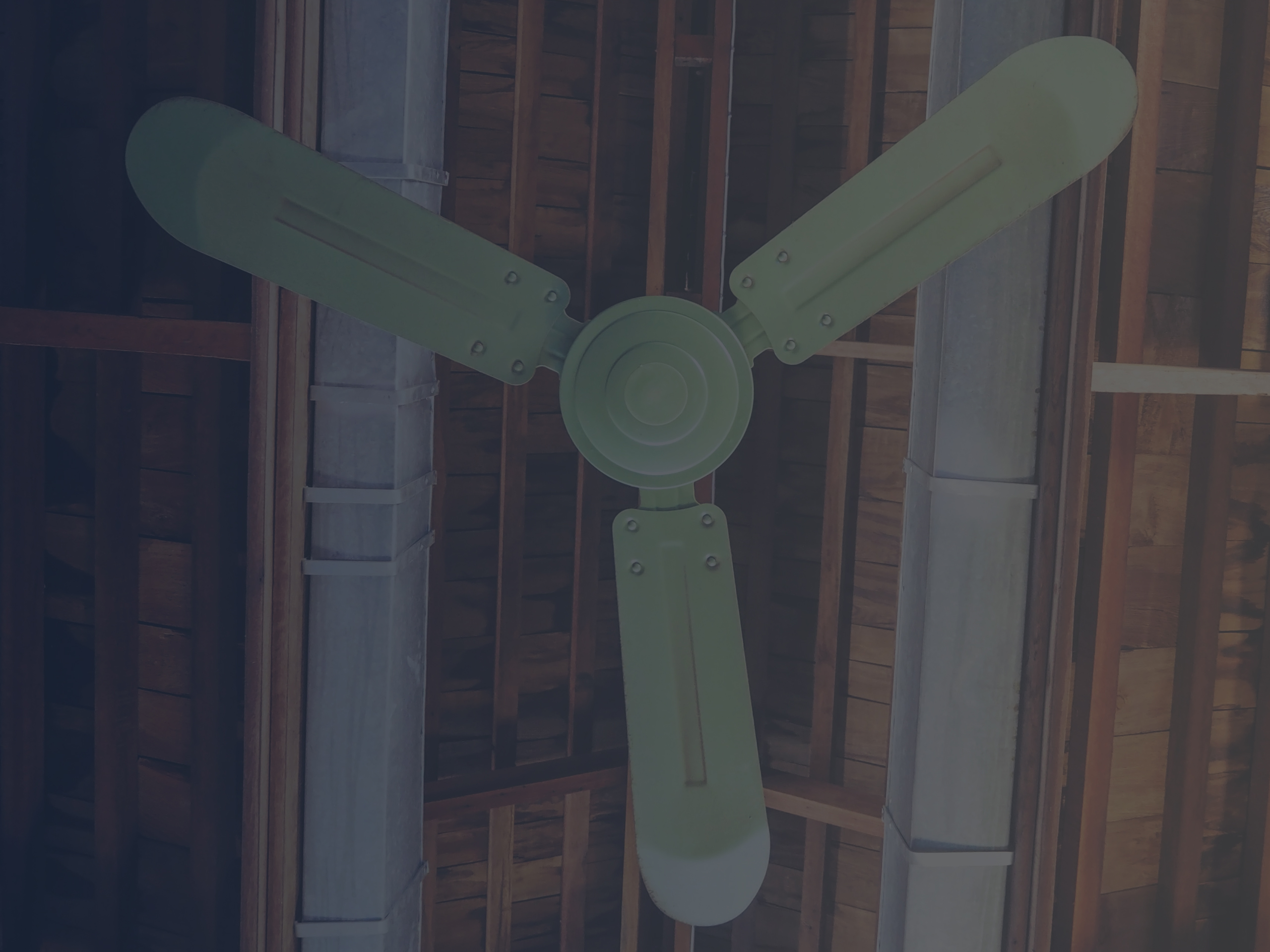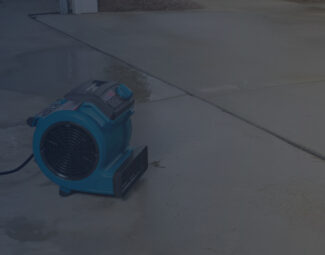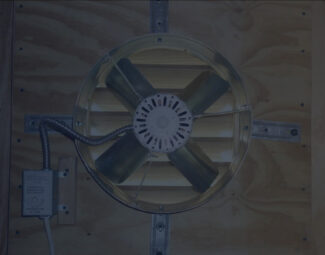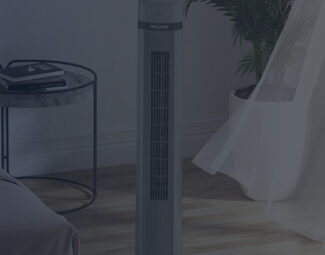Q uite popular as they are completely out of the way and supply the soothing breeze you seek to keep cool during hot weather, ceiling fans are common in households all around the world. They come in various shapes and sizes, the multitude of options being a plus but also making your choice a bit harder.
Before you purchase a fan, though, there is one aspect you need to examine, and that is sizing. How do you determine the size that is the most fitting for a ceiling fan? What do you have to take into account? Continue with us and you will learn everything you need to know to pick a model that moves the stagnant air with optimal efficiency in the room of your choice.

Ceiling Fan Hanging Above Dining Room Table
How does it work?
It turns the pitched blades to create an airflow that improves air circulation in the room. This breeze makes you feel cool when it hits your skin (or warm when set in reverse). Just remember that this is only a sensation produced by the airflow as the fan alone does not change room temperature. It does, however, improve the effectiveness of the AC unit or heating system if you use the fan alongside one of them. In this sort of circumstance, it can amp the temperature modification produced by the AC or heater.
Ceiling Fan Size Guide
Let’s start from the beginning. Before you can match the fan to your space, you have to learn how to measure its size. To do this, you must take out a tape measure and see what the distance is from blade tip to blade tip. Easy, right? Just as easy is to find an appropriate-size fan if you use the guidelines supplied in this table:
Blade size |
Room size |
|---|---|
Below 29” |
Up to 50 sq. ft. |
29” – 36” |
50 to 75 sq. ft. |
42” – 48” |
75 to 175 sq. ft. |
52” – 56” |
175 to 350 sq. ft. |
60” or larger |
Over 350 sq. ft. |
Note: If it is an outdoor space that you intend to install the fan for, always go one size larger when you pick the product. The same goes if the ceiling is very tall or vaulted. However, if you have an unusually shaped room or inset ceilings, you should ask for professional help when sizing the fan.
Luckily, there’s not much to sizing a ceiling fact, it’s all pretty straightforward. But proper sizing isn’t all, it’s just the first step in picking the right fan for your space. In the following, we will look into some other factors that weigh when you make this acquisition. But first, let’s recap fan sizing according to specific areas and spaces to make matters clearer for you:
What to pick for the bedroom:
A regular-sized bedroom is approximately 144 to 225 sq. ft. in size, which means that you would best be served by a fan that measures from 52” to 56” in blade size and that can move from 1,600 to 4,500 CFM. You can go a bit lower too, 40” and up for the fan blade size. We recommend that you go for a higher airflow capacity model (but not much higher) and adjust the settings as you see fit according to temperature conditions.
What to pick for other indoor spaces:
The procedure is the same as it is with the bedroom. Simply measure the space, match it to the values in the table above, and you have an estimated sizing of the fan. As aforementioned, do modifications and go one value higher only if the ceiling is vaulted or higher than the standard 8’.
What to pick for an outdoor living space:
Regardless if we are talking about a patio or an outdoor kitchen, what you must do is take the measurements of the space, match the number to the value in the table above, and go one size higher for the blade length. Outdoor areas are more demanding when it comes to air circulation, so you must comply with the difference if you want it to make a difference in cooling you off.
Does the Number of Blades Matter?
Back in the day, before the design of these fans was upgraded, it was commonly known that a ceiling fan with 5 or 6 blades is more efficient than a model with only 3 or 4 blades. Nevertheless, this is not the case anymore. Now, the same CFM is provided regardless of the number of blades featured.
Now, it comes down to noise, aesthetics, and drag when selecting the number of blades. A fan with 5 or 6 blades might be considerably quieter when it runs and look more aesthetically appealing, but it puts more drag on the motor as well. Fewer blades give the fan a more modern look and feel, and while this setup is usually noisier, it doesn’t put any strain on the motor. In the end, when it comes to blade count, the decision is completely up to you as it does not affect the performance of the air circulator.

Green Vintage Fan Hanging from Ceiling
Guidelines to Follow when Shopping
Sizing might be at the forefront of the list, but it’s not the only criteria that you should consider when you get a ceiling fan. In fact, there are quite a few elements to consider, and in the following, we will go over each one to help you buy the right product. Here it goes:
- Start with proper sizing: The topic of our current discussion is the first matter you need to look into when you acquire the fan. As long as you make sure that it can provide the airflow you need to maintain the room cool, you won’t ever feel like the fan is underperforming.
- Hanging height: To meet regulations, you must make sure that the fan sits at least 7’ off the floor (ideally, it should sit at 8’ or 9’ for optimal air circulation). There should also be a gap between the ceiling and the blades for airflow and circulation to not be affected. A minimum of 12” is recommended when it comes to this aspect. If you have a low ceiling, a flush mount model is suited for the job, whereas, if the height is average or high, you should opt for a longer downrod, one that suits the situation at hand.
- Check the blade angle: A minimum 12-degree angle is needed so that the air is pushed upward and downward effectively. We recommend that you opt for a blade angle from 12 to 14 degrees. If the angle exceeds 16 degrees, it will push a much bigger amount of air in one go, making it seem more like you just strapped a box fan to the ceiling.
- Consider a light assembly to amp its usefulness: Price-wise, the difference between a fan that features light assembly and one that doesn’t is not high. For better lighting in the room and to save up wall space, we recommend that you either replace the pre-existing ceiling fixture with a fan that comes with light assembly or simply directly install one that features it. It will be considerably more inconvenient to add it later down the road, so look into this feature from the get-go.
- The presence of a thermostat can do wonders: This is a feature that few models come with, but it would be in your best interest to acquire one that has it. Fans that feature a thermostat turn on and off based on your activity just like modern air conditioners do, so you can see why it would come in handy.
- Make it good for year-round use with a reversible motor: With a reversible motor, you have the option to operate the blades either clockwise or counterclockwise. The clockwise setting spreads a warm breeze into the room, whereas the counterclockwise setting produces the cooling breeze that saves you during torrid days when temperatures go up too much.
For optimal efficiency, pair the fan with a portable air conditioner that provides cooling and heating capabilities. The fan spreads the air in the chamber, while the AC changes the actual temperature through its functioning. This way, the fan will disseminate cool air in summer and warm air in winter to amplify the efficiency of the AC and cut down on running expenses as you won’t need to turn the thermostat as high or as low as you had to prior.
How to Make the Most of It
Before we conclude our article, let’s explore some of the tricks you can employ to maximize the potential of the fan and even reduce energy usage. Here are some of the important tips for utilizing a ceiling fan more effectively:
- Go counterclockwise in hot weather: If it features reverse settings, you are in luck as it can be utilized year-round. Let’s start with the counterclockwise setting as this is the one you will use in summer and whenever it gets too hot inside. What it refers to is that the blades will turn counterclockwise, which implies that the air is blown down, the air movement produced at the room’s center producing the cooling breeze effect when it impacts your skin.
- Go clockwise in cold weather: As the blades turn, they pull up air from the middle of the chamber and push it down near the sides. This produces a combination of warm and cool air so that a constant temperature is maintained. What you will feel as a result is a warm breeze that hits your skin, so you won’t feel as much of a need to turn up the heater as you normally do.
- Use the AC thermostat to your advantage: If you also have an air conditioner, you should turn the thermostat higher than before you installed the fan. Its purpose is to distribute the air in the chamber and produce a breeze effect that makes the whole place feel cooler than it is. Thus, you don’t need to set the temperature as low as you did before to feel thermal comfort relief.
- Turn it off when you go away: Leaving it on could be hazardous in case anything goes haywire, so there is the implication of safety involved with turning it off. However, there is another reason behind this advice as well – it is pointless to keep it on if you are gone for a considerable amount of time. This would waste a lot of money uselessly, so if the fan does not feature a thermostat that would automatically turn it off when thermal comfort is reached, you should shut it off yourself before you leave.
Final Thoughts
Regardless if you are interested in purchasing a ceiling fan for the bedroom, living room, or any other area of the house, you are sure to have all of the facts straight now when it comes to sizing. As this is the first and most important step toward making a successful purchase, rest assured knowing that you won’t fail and that the one you install provides the needed circulation for the area it is used in.












